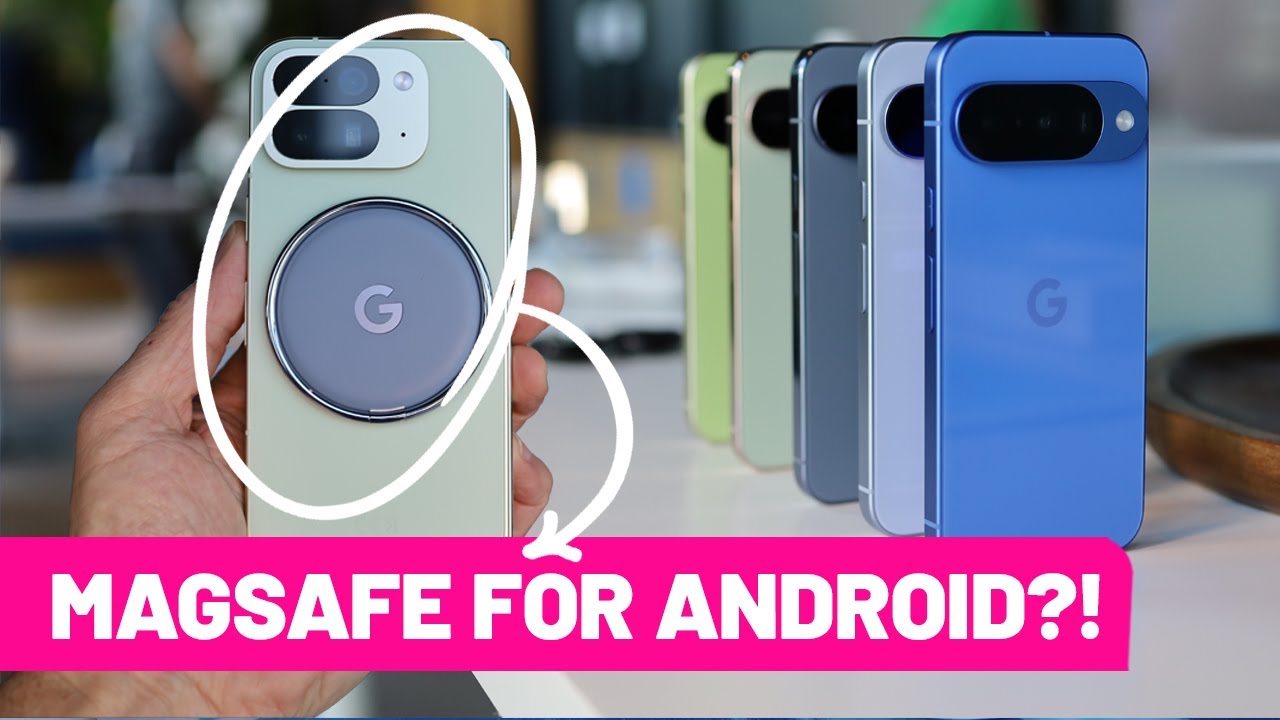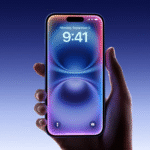Why you can trust TechRadar
We spend hours testing every product or service we review, so you can be sure you’re buying the best. Find out more about how we test.
The Google Pixel 10 Pro and its larger sibling, the Pixel 10 Pro XL, look like fantastic smartphones – Google hasn’t messed with the winning formula that made the Pixel 9 Pro my phone of the year choice for 2024. The refinements seem minor, but could signal a sea change in Google’s fight against Apple and its friendly competition with Android rival Samsung. I only had a few hours with these phones, but they look like the best Pixel phones yet – and some of the coolest features have yet to reveal themselves.
Google doesn’t compete with Samsung on specs or with Apple on features, so it’s been easy to dismiss past Pixel phones as also-ran devices that offer a nice alternative to the iPhone and Galaxy lines, but are rarely the first choice. That changes with the Pixel 10 Pro.
The new Pixelsnap magnet features may seem like old news to iPhone users, but they open up a world of new accessories and convenience for Android fans. I’m pretty sure that Samsung and OnePlus will follow suit in due course, but for now the Pixel 10 Pro and its three stablemates are the only Android phones that I can snap onto my bedside charging stand (sorry iPhone 16 Pro) and use with my UAG magnetic wallet.
I only had a couple of hours with the Pixel 10 Pro and Pro X, so the most important features remain a mystery right now. Google says it has upgraded the image signal processor in the Tensor G5 chipset, which should result in better photos, and possibly a better camera experience.
The new Camera Coach feature is totally fascinating, but it wasn’t working on the demo units I tried. Some Google reps had it working on their own phones, so the feature seems baked and ready to serve, but I’ll need to spend a lot of time using the cameras in a variety of situations to see if it really makes a difference.
If it does, it could be a turning point for smartphone AI features. So far, AI on smartphones has been a mix of useful tools and frightening oversteps. The Pixel 9 Pro is my favorite AI phone because it does a great job of screening calls, recording meetings, and managing notifications.

Watch On
Those are genuinely useful AI tools, not image generators that make lousy (or possibly offensive) images, or writing tools that take over the job of sending love notes to my sweetie. The Pixel 10 Pro promises a host of new and similarly useful AI features, but none of them were apparent in my hands-on time.
The new Magic Cue feature will need to get to know me better before it starts bubbling up relevant information during my phone calls. When it does know me, it should do things like showing me my flight information if it hears me talking about my upcoming travel plans. I hope it works well, but so far AI features like this from other phone makers have failed to materialize after launch, or have failed to demonstrate the utility that phone makers claim.
I’m not too concerned. The Pixel 9 Pro was already ahead of the competition on useful AI features, and Google is doing an admirable job of keeping the AI processing – and therefore your private data – on the device instead of relying too much on cloud computing.
I saw a Pixel 10 Pro translate the voice of my colleague on a phone call from his English into a natural-sounding Spanish. Other phones can do the translation bit, but the Spanish voice actually sounded like my colleague would if he spoke Spanish! Most astonishingly, all of the processing happened on the Pixel 10 Pro, not in the cloud. The conversation and the sound of your voice are kept private.
In other words, after spending a couple of hours with the Pixel 10 Pro and Pixel 10 Pro XL, they seem to me like refined devices that marginally improve on the success of last year’s redesign, and that’s enough for me. If the Pixel 10 Pro simply offers camera improvements and better zoom, along with all of the latest Pixel features I already enjoy, I’ll be able to recommend it easily.
If the new AI features really help me take even better photos and do a better job of helping me organize my digital life, I’ll consider that an even bigger win, but I think we’re only seeing the tip of the AI iceberg on these phones. With seven years of Android updates ahead, who knows what the Pixel 10 Pro will be capable of doing in the future.
Pixel 10 Pro and Pro XL hands-on review: Price & availability
The Pixel 10 Pro and the Pixel 10 Pro XL both come with 16GB of RAM inside and 256GB of storage to start. Those are very respectable specs, and most people won’t need to spend more for more storage, unless there’s a great discount if you buy more space.
The phone comes in four colors: blue-grey Moonstone, light-green Jade, white Porcelain, and dark-grey Obsidian. The Moonstone is very appealing, but I like all of this year’s colors equally, even the blackish Obsidian. I do wish there were more vibrant color options, but subtle seems to be the new norm for Pro-level phones.
The Pixel 10 Pro and Pixel 10 Pro XL are priced high, but the price is competitive with the top-end iPhone 16 Pro and Galaxy S25 Ultra phones. The new Pixels don’t measure up evenly spec-for-spec, but the overall experience is just as good, and the Pixel 10 Pro and Pro XL are the newest-looking phones of the bunch, with the most recent redesign.
While I expect the base-model Pixel 10 will drop in price throughout the next year, Google has been more stingy with its Pro models recently. Last year’s Pixel 9 Pro saw regular discounts of $150 in the US, but rarely dropped further than that, and discounts were less common on this phone than on the base model. The price is pretty good, though, so if you want a Pixel 10 Pro, buy it now – there probably won’t be a huge deal coming that makes you regret buying early.
Pixel 10 Pro and Pro XL hands-on review: Specifications
The Pixel 10 Pro launches with 256GB of storage on the cheapest model, a step up from last year, and the same storage and 16GB of RAM inside both the Pixel 10 Pro and 10 Pro XL. The specs are nearly identical across the two phones, but the differences are significant enough to consider before you buy.
The Pixel 10 Pro XL has a larger display, of course, and that means a larger battery inside as well. It uses a big 5,200mAh cell, compared to the 4,870mAh battery in the Pixel 10 Pro. I’ll need to test these phones thoroughly before I can tell you if the larger battery makes a big difference.
The Pixel 10 Pro XL is also the only Pixel 10 phone that can charge wirelessly up to 25W, which is the full potential of today’s Qi2 wireless standard. The Pixel 10 series is the first phone family with Qi2 certification, including the magnets that make Pixelsnap features possible, but the other two phones charge at 15W, not the full 25W speed.
Otherwise, both of these phones pack the Google Tensor G5 processor inside, which has a new and improved image signal processor that should improve image quality and help you take better pics. Both phones have the same 50MP main camera and two 48MP sensors behind the ultrawide and 5x zoom lenses, as well as the same 42MP selfie camera up front.
|
Dimensions: |
152.8 x 72.0 x 8.6mm |
|
Weight: |
204g |
|
Display: |
6.3-inch Actua display |
|
Resolution: |
1080 x 2424 pixels |
|
Refresh rate: |
60-120Hz |
|
Peak brightness: |
3,000 nits |
|
Chipset: |
Google Tensor G5 |
|
RAM: |
12GB |
|
Storage: |
128GB / 256GB |
|
OS: |
Android 16 |
|
Wide camera: |
48MP; f/1.7; 0.5-inch sensor |
|
Ultrawide camera: |
13MP; f/2.2; 0.33-inch sensor |
|
Telephoto camera: |
10.8MP; f/3.1; 0.31-inch sensor |
|
Selfie camera: |
10.5MP; f/2.2 |
|
Battery: |
4,970mAh |
|
Charging: |
25W wired; 15W wireless Qi2 |
|
Colors: |
Indigo, Frost, Lemongrass, Obsidian |
Pixel 10 Pro and Pro XL hands-on review: Design
The Pixel 10 Pro and Pixel 10 Pro XL look nearly identical to last year’s Pixel 9 Pro and Pixel 9 Pro XL, and that’s a good thing. The iPhone and Galaxy lines have been stagnant for years, using the same basic design, while Google made a significant improvement to its Pixel design last year.
The new Pixel look is more durable than before, and Google reiterates that the Pixel 10 Pro is twice as durable as the Pixel 8 Pro, which used the older camera-bar design. The Pixelsnap magnets inside haven’t added any bulk to the latest phones, either, so the devices are just as thin as last year’s models.
For better and worse, the Pixel 10 Pro looks almost identical to the base model Pixel 10 as well. You’d need an expert guide to tell them apart – the Pixel 10 Pro uses a matte finish on the back and glossy sides, while the Pixel 10 flips that script and uses a glossy back with matte side rails.
The easiest difference to spot is the temperature sensor on the Pixel 10 Pro and Pixel 10 Pro XL, which somehow still exists even though it’s one of the more useless hardware additions I’ve seen in recent years.
For color choices, I liked the Moonstone quite a bit, but it was admittedly drab. The green Jade might be my favorite color, but the black and white options are also very appealing, with that nice matte finish making them look more professional.
Pixel 10 Pro and Pro XL hands-on review: Display
Google doesn’t brag enough about its Super Actua displays on the Pixel Pro phones, and the Pixel 10 Pro and Pro XL models were incredibly bright and colorful in the time I spent testing them. Seriously, Google’s Pixel displays are quietly the best screens on any smartphone – even better than Samsung’s. They look great in every lighting condition.
In my morning with the Pixel 10 Pro and Pixel 10 Pro XL, I found the displays to be satisfyingly bright and very sharp. Google has great custom wallpapers and themes that match the phone’s color, and this makes the display pop even more when you twirl the device in your hand to get an overall look.
Of course, I’ll need to spend more quality time with these phones to see if the display really holds up in bright sunlight. Google claims these phones can reach 3,300 nits of peak brightness, but I’ll have Future Labs confirm these claims before I give Google the credit.
I’m also curious to see how the Pixelsnap feature makes the Pixel 10 Pro into a bedside clock. I use the Standby feature on my iPhone 16 Pro Max every night, and I intend to use the Pixel 10 Pro XL as my new alarm clock – I hope it provides a better experience than iOS.
Pixel 10 Pro and Pro XL hands-on review: Software
Software is the biggest question mark with the Pixel 10 Pro and Pixel 10 Pro XL. With the new Google Tensor G5 chipset, Google is claiming the Pixel 10 Pro does even more AI processing on the phone than any competitor phone I’ve used. I’m curious to see how effective these AI tools will be, and if performance benefits when the Pixel 10 Pro doesn’t need to call the cloud for every request.
With the new Magic Cue features, Google is finally getting into the game of letting the phone know everything about me in order to make useful suggestions. I’m not sure how it will work, but eventually the Pixel 10 Pro will hear what I am saying and offer information from my personal life to help with context, for example flight reservations if it hears me talking to a friend about an upcoming trip.
Apple had a very hesitant launch with this feature on Siri, and eventually delayed the idea entirely. It still hasn’t materialized. Samsung is trying to use data from all of my smart devices and my smart home together, but the results have been disappointing – I haven’t seen any personal suggestions from my Galaxy phone even after months of using those features.
Other phone makers like OnePlus and Nothing tend to rely on the AI reading screenshots and photos, and not your Gmail messages. I’m interested to see if Google has finally cooked up a winning recipe for a useful AI assistant that knows me personally, but doesn’t creep me out with that knowledge.
Pixel 10 Pro and Pro XL hands-on review: Cameras
The Pixel 10 Pro and Pixel 10 Pro XL don’t get a camera upgrade this year – Google is sticking with the same 50MP main camera and twin 48MP ultra-wide and zoom cameras that were on last year’s Pixel 9 Pro and Pro XL. Instead, the improvements are software-based, thanks to AI improvements that Google says are possible with the Tensor G5 chipset.
Unlike the Pixel 10, the Pixel 10 Pro and Pro XL models has features like high-resolution portrait shots, and an advanced Video Boost feature that will stabilize your videos even better than before. All of the new Pixel 10 phones get Pro Res zoom powered by AI, but the Pixel 10 Pro and Pro XL will reach up to 100x telephoto range, farther than the 30x Pro Res zoom on the Pixel 10.
Just like last year, the Pro and Pro XL models have the exact same camera specs – no need to buy the bigger phone just because you want more zoom.
The Pixel 10 Pro uses a smaller sensor than Apple or Samsung on its main camera, but Google relies on a lot more computational photography techniques to fix up images after you take the shot.
I tried the Pro Res zoom in my time testing the phone, and I definitely noticed how it could smooth images and reduce the significant noise that occurs at the 100x range. I’ll need to see the final images up close on my big monitor before I decide whether or not this feature makes those long zoom shots worth keeping.
I’m also very curious about the Camera Coach features, which will help you rearrange your shot to get the best composure and lighting. Will it tell me to move my camera around, or turn on a different lamp? Will it suggest I use the flash, or maybe switch to Night mode?
I’ll need to test the feature in a variety of situations, but I’m excited about the possibilities – I prefer AI features that help me improve my picture-taking to features that make the picture for me.
Pixel 10 Pro and Pro XL hands-on review: Performance
The Pixel 10 Pro and Pro XL use the same Tensor G5 chipset as the Pixel 10 and Pixel 10 Pro Fold, but the Pro models get 16GB of RAM instead of the 12GB in the base model. That should help with performance, especially when it comes to tackling AI processing on the device itself, without tapping Google’s cloud computers for help.
Google’s Pixel phones have never been performance powerhouses, and I’m not expecting these phones will dominate benchmark tests from Future Labs. I couldn’t download any games in my hands-on time, but in my experience games will run just fine, although hardcore gamers looking to max-out graphics should find a faster phone.
Still, Google’s Tensor chips enable AI features that other phones often can’t match. The Pixel phones are the best at transcribing my voice accurately, for instance, and the Pixel 10 Pro also has some astounding new AI features, like the live translation that mimics the sound of your voice as it translates your speech.
My hope is that Google’s custom chips pay dividends down the road as Google adds more AI features to Android. The Pixel 10 family will all get major Android updates for the next seven years, which should take them from today’s Android 16 to Android 23.
That means today’s AI features are important, but tomorrow’s AI features will be even more advanced, and I’m hoping that Google has a long-term roadmap that keeps the Tensor chipset fresh as it improves Android. I’ve been very impressed by Qualcomm’s Snapdragon 8 Elite chips this year, so Google is going to need to do more to justify using its own designs instead of Qualcomm’s proven winner.
Pixel 10 Pro and Pro XL hands-on review: Battery
As I only spent a couple of hours with the Pixel 10 Pro and Pixel 10 Pro XL, battery life remains a question mark, but I’m hoping that it will be easier for most folks to keep these phones topped up and charged throughout the day.
Having Pixelsnap accessories that work with MagSafe charging will be very convenient. The batteries in both the Pixel 10 Pro and Pixel 10 Pro XL are bigger than last year’s models, even though the phones now have magnets inside for Pixelsnap. That’s an impressive design achievement.
Sadly, the Pixel 10 Pro doesn’t take full advantage of the new Qi2 wireless charging standard. The Pixel 10 Pro XL can charge at up to 25W on a wireless, Qi2-certified charger, while the Pixel 10 Pro can only charge wirelessly up to 15W, so it won’t charge faster than previous Pixel phones, but it will still have the convenience of magnets.
The final say on battery life will come after Future Labs tests these phones with our proprietary battery rundown tests. The recent crop of Android phones with the Qualcomm Snapdragon 8 Elite processor inside have shown remarkable gains in battery life, so I’m hoping that Google has learned some tricks to improve the Pixel 10 Pro’s battery as well.
Read the full article here














